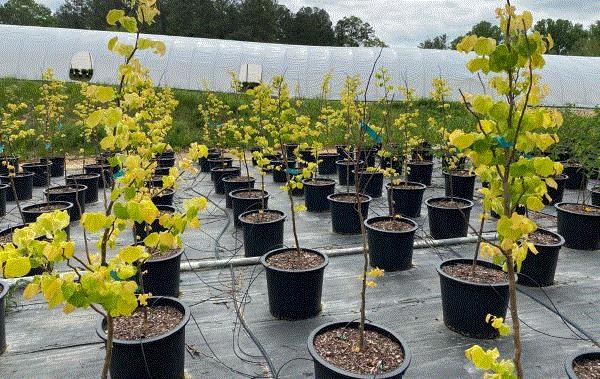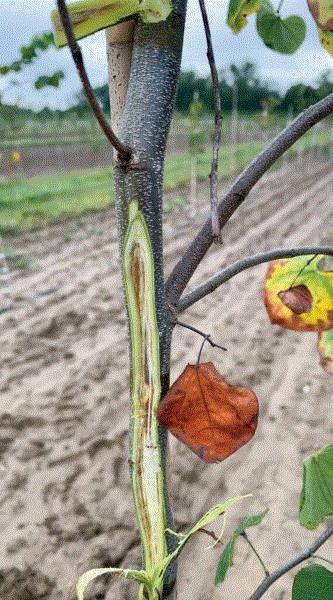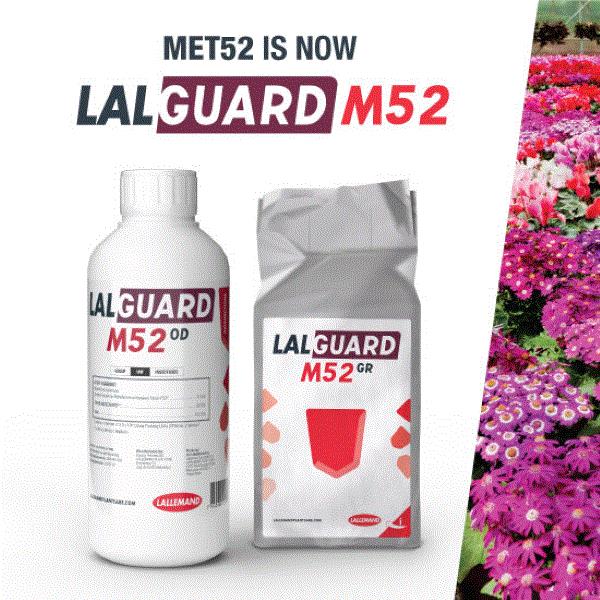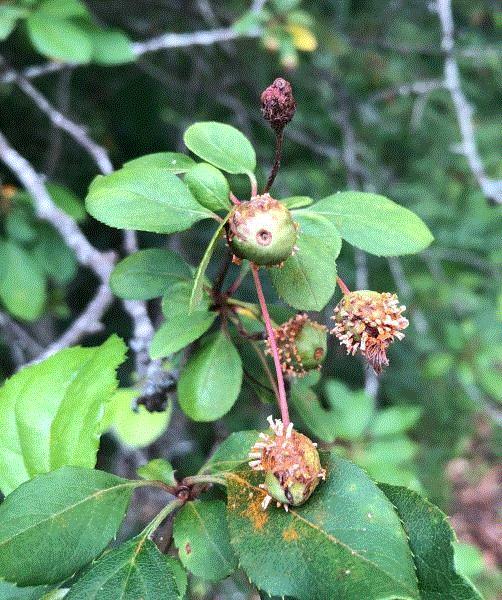Watch for Vascular Streak Dieback
Devin Bily of the Virginia Department of Agriculture & Consumer Services, and Elizabeth Bush of Virginia Tech University recently published an alert on vascular streak dieback (VSD). This is a new disease that causes severe wilting and dieback of nursery trees, and has been confirmed in Florida, Indiana, North Carolina, Tennessee and Virginia. Devin and Elizabeth reported that, in some nurseries, 90% to 100% of stock was damaged to being unsellable. Read the alert HERE.
VSD is caused by a fungus, Ceratobasidium theobromae. Symptoms progress from leaf chlorosis or scorching and stunting of new growth to severe wilting of trees. Wilting typically starts from the top and progresses downward. The infected trees eventually die once the pathogen invades the main trunks and destroys the vascular tissues. The infection leaves streaking or discoloration within the vascular tissues (and gives the disease its name), which becomes quite evident when the symptomatic stems or trunks are cut.
Devin and Elizabeth’s alert, as well as an earlier article by Janna Beckerman, Tom Creswell and John Bonkowski of Purdue University, and Fulya Baysal-Gurel of Tennessee State University contain excellent photos of the disease symptoms.

Chlorotic redbud trees infected by VSD. (Photo credit: Devin Bily, Virginia DACS.)
Interestingly, VSD is sometimes associated with cankers infected by Botryosphaeria and Phomopsis, which take advantage of the weakened trees. I’d seen these canker diseases in southern nurseries at greater and greater frequency. I wonder how much of what I thought were Botryosphaeria or Phomopsis cankers were actually VSD? I’m not a pathologist, so I’m liable to make a fool out of myself (see the last story below). VSD symptoms can be confused with other diseases, such as verticillium wilt and Phytophthora root rot, and even boring insects! Don’t be a fool like me—get your symptomatic plants diagnosed!
VSD is impacting trees grown in pots, fields and landscapes. The infections reported in landscapes were likely associated with new plantings of previously infected trees. According to Devin and Elizabeth, the most impacted species in Virginia are redbud, maple and dogwood. However, they also listed other susceptible plant species in their alert. Mike Munster of North Carolina State University reported that redbud is the most affected species, followed by flowering dogwood and maple.

Streaks in the trunk of an infected tree. (Photo credit: Tom Creswell, Purdue University.)
What can you do if your trees are affected by VSD? Devin and Elizabeth’s article provides some good suggestions on management approaches. First, improve the growing conditions by proper irrigation, media management, spacing, avoid herbicide injury, etc. Then you need to make sure the disease doesn’t spread. You should remove symptomatic stocks or stems, propagate only healthy or clean materials, disinfect tools, etc.
It’s important to understand that fungicide treatment won’t be able to rescue an infected tree, so the best thing to do is to cull and properly dispose of the infected tree.
Research is on-going to identify the most effective fungicides for treatment against VSD. For now, soil drench treatments with fungicide in FRAC Group 3, 7, 11 and 12 (which have good efficacy against Rhizoctonia) should be able to provide protection. Click HERE to access a list of recommended fungicides.

Met52 is Back!
Y'all remember Met52, right? This is a bioinsecticide containing Metarhizium brunneum (formerly known as Metarhizium anisopliae), an entomopathogenic fungus. Met52 was marketed by Novozymes for several years. Quietly, however, this product disappeared from the market.
It’s back under the trade name LALGUARD M52 by Lallemand Plant Care. I’ll call the product M52 for now. M52 is available in two formulations—OD (oil dispersion) and GR (granular).

Both formulations are registered for use in indoor and outdoor sites (greenhouse, nursery, landscape and lawn), and on ornamental plants, turfgrass, and certain vegetable and berry crops. Target pests of M52 OD include thrips, whiteflies, flies, aphids, psyllids, weevils, mites and ticks. M52 OD can be applied as foliar spray or soil drench, and the restricted entry interval (REI) is four hours.
M52 GR, on the other hand, is registered for the management of thrips pupae, weevil larvae and ticks. M52 GR is used for nursery media mix or a broadcast, with a REI of 12 hours. The required personal protective equipment (PPE) for both formulations are coveralls, gloves, shoes plus socks, protective eyewear and respirator.
Based on a presentation handout dated September 2018 and prepared by folks at Novozymes, Met52 is compatible with most predators and parasitoids, except the parasitoid Aphidius rhopalosiphi, the predatory midge Aphidoletes aphidimyza and the predatory mite Gaeolaelaps gillespiei. Met 52 is also compatible with most fungicides applied by foliar spray and media drench, but you may want to avoid foliar application of azoxystrobin, boscalid, captan, chlorothalonil, mancozeb and thiram. Again, this is old information—y’all should talk to folks at Lallemand Plant Care for the most up-to-date information on compatibility.
Visit Lallemand Plant Care's website or find them at their booth at Cultivate'23 (booth #2413).

Pests to Watch for This Mum Season
Many of us are deep in the mum season. I think this is a good time for me to make a few reminders on bugs and diseases to watch for during the early stage of the mum crop.
If you’re still in the propagation stage, certainly look out for fungus gnats and spider mites. These two pests can be rather sneaky, so problems (fungus gnats gnaw on roots and mites discolor leaves) may not be detected until you've lost a good portion of the propagative materials. Thrips can also be a problem at this time of year.
The propagation stage is when disease management is critical. That’s because the environment conducive to rooting is also beneficial to some diseases, such as Botrytis, and root and crown rots. Moisture and media management is crucial to reducing disease pressure. Preventive spray and media drench of conventional and biofungicides may be needed during propagation just to keep diseases at bay.
Once the plants get going, spider mites and Rhizoctonia will continue to be an issue if infection isn’t under control in the propagation phase. Botrytis will also continue if plant spacing and airflow aren’t well managed. Aphids, thrips, caterpillars, leafminers, Pythium, Fusarium, bacterial leaf spot and chrysanthemum white rust will start to raise their ugly heads. It’s important to scout regularly, find the problems early and treat against the problems early.
I had a more detailed discussion on pest management in mum crops in this newsletter about a year ago. Click HERE to read the Special Mum Edition of this newsletter.

Those Aren't Telial Horns, You Dummy!
I’m sure my wife’s dog calls me dummy, creepy old man and all sorts of other names every day. I’m simply not smart enough for that little dog. And she’s going through that teenage phase at two human-years old. It’s so hard for her!
I made a mistake in the last issue when I called the gelatinous protrusions from the fruits of crabapples telial horns and my dear colleague Steve Jeffers at Clemson University called me out on that. Well, via a private email to spare my feelings. What Steve doesn’t know is I need folks like him to keep me straight. So thanks, Steve!

Back to my mistake! Apparently telial horns are only formed on red cedars. What I thought were telial horns on crabapple fruits are actually aecia, which release aeciospores (those yellow powder on the leaf in the picture). Aeciospores are carried by wind to red cedar, starting a new cycle. Telial horns don’t release teliospores. Instead, germinating teliospores produce basidia and basidiospores are what are being released to form rust on crabapples. Aecia and spemagonia are then produced on crabaple leaves and fruits. Cornell Extension has a good fact sheet with a wonderful diagram that illustrates the life cycle.
This complicated life cycle makes my head hurt. I’ll go lay down now ...





See y’all later!

JC Chong
Technical Development Manager at SePRO
Adjunct Professor at Clemson University
This e-mail received by 27,847 subscribers like you!
If you're interested in advertising on PestTalks contact Kim Brown ASAP!